
A | B | C | D | E | F | G | H | CH | I | J | K | L | M | N | O | P | Q | R | S | T | U | V | W | X | Y | Z | 0 | 1 | 2 | 3 | 4 | 5 | 6 | 7 | 8 | 9
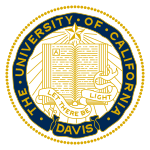 | |
Former names | University Farm (1905–1922) Northern Branch of the College of Agriculture (1922–1938) College of Agriculture at Davis (1938–1959) |
|---|---|
| Motto | Fiat lux (Latin) |
Motto in English | "Let there be light" |
| Type | Public land-grant research university |
| Established | 1905 (1959 as a general UC campus) |
Parent institution | University of California |
| Accreditation | WSCUC |
Academic affiliations | |
| Endowment | $2.25 billion (2021)[1] |
| Budget | $7.1 billion (FY 2024)[2] |
| Chancellor | Gary S. May[3] |
| Provost | Mary Croughan[4] |
Academic staff | 2,133 (Fall 2017)[5] |
| Students | 40,850 (Fall 2023)[6] |
| Undergraduates | 31,797 (Fall 2023)[6] |
| Postgraduates | 9,053 (Fall 2023)[6] |
| Location | , , United States 38°32′24″N 121°45′0″W / 38.54000°N 121.75000°W |
| Campus | Small suburb[8], 7,331 acres (2,967 ha)[7] |
| Other campuses | |
| Newspaper | The California Aggie |
| Colors | Aggie blue and gold[9] |
| Nickname | Aggies |
Sporting affiliations | |
| Mascot | Gunrock the Mustang |
| Website | www |
| ASN | 6192 |
The University of California, Davis (UC Davis, UCD, or Davis) is a public land-grant research university in Davis, California, United States.[10] It is the northernmost of the ten campuses of the University of California system. The institution was first founded as an agricultural branch of the system in 1905 and became the seventh campus of the University of California in 1959.
Founded as a primarily agricultural campus, the university has expanded over the past century to include graduate and professional programs in medicine (which includes the UC Davis Medical Center), law, veterinary medicine, education, nursing, and business management, in addition to 90 research programs offered by UC Davis Graduate Studies. The UC Davis School of Veterinary Medicine is the largest veterinary school in the United States. The UC Center Sacramento, a public-service oriented program founded in 2004, is operated by UC Davis.[11] UC Davis also offers certificates and courses, including online classes, for adults and non-traditional learners through its Division of Continuing and Professional Education.[12]
The university is classified among "R1: Doctoral Universities – Very high research activity".[13] The UC Davis Aggies athletic teams compete in NCAA Division I, primarily as members of the Big West Conference with additional sports in the Big Sky Conference (football only) and the Mountain Pacific Sports Federation. Athletes from UC Davis have won a total of 10 Olympic medals. University faculty, alumni, and researchers have been the recipients of two Nobel Prizes, one Fields Medal, a Presidential Medal of Freedom, three Pulitzer Prizes, three MacArthur Fellowships, and a National Medal of Science.[14][15][16][17][18]
History
Agriculture and the land-grant university
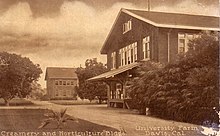
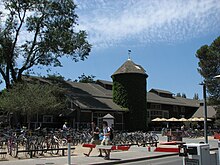
In 1868, the University of California was established as a land-grant university, and immediately founded a College of Agriculture as its first college as required by the Morrill Land-Grant Acts and the university's own Organic Act.[19][20] UC operated a small farm at the Berkeley campus for several years after Ezra S. Carr became professor of agriculture, but he managed to alienate both the university faculty and the state's farmers with his attempt to directly integrate practical training in farming with courses on the larger historical, social, and political dimensions of farming and got himself fired in 1874.[21] The faculty could not understand why students should earn credit towards degrees for hoeing or plowing, and the farmers could not understand how learning the social history of farming could make their children into better farmers.[21]
Eugene W. Hilgard, Carr's successor, recognized that Berkeley's soil and climate were terrible for farming (the campus directly faces the notoriously foggy Golden Gate) and switched from "practical" to what he called "rational" instruction in scientific principles of agriculture at Berkeley.[22] He concentrated on things like soil science and fermentation that could be researched and taught in a university laboratory, supplemented by limited data gathering and experiments (but not hands-on teaching) at agricultural experimental stations in the field.[23] Hilgard was disdainful of the idea of a university farm.[24] He felt that for such a farm to teach effectively, it would necessarily have to be a model farm with examples of the best of everything, without any reference to local profitability, climate, or circumstances, and such a thing was clearly infeasible.[24]
Founding of the university farm
Around the turn of the 20th century, Peter J. Shields, secretary of the California Agricultural Society, became aware that colleges of agriculture elsewhere had university farms which performed experiments and provided hands-on education in useful agricultural subjects, and that young people were leaving the state to study at such farms.[25] Shields began to champion the cause of a university farm. He was later honored as the "founder" of UC Davis in 1962, when the Shields Oak Grove on campus was named after him, and again posthumously in 1972 when the campus library was named after him.[26] However, local farmer and politician George Washington Pierce Jr. also fought hard in the California State Assembly for the creation of a university farm, and influenced the drafting of the site criteria in the University Farm Bill to ensure that Yolo County would become the selected site—but unlike Shields, did not live long enough to see the promotion of Davis to a general campus and is now largely forgotten.[26]
On March 18, 1905, the University Farm Bill was enacted, which called for the establishment of a farm for the University of California.[27] A committee appointed by the Regents of the University of California took a year to select a site for the University Farm, a 779-acre portion of the stock farm of Jerome C. Davis, near a tiny Yolo County town then known as Davisville.[27][28] The Regents officially took control of the property in September 1906 and constructed four buildings in 1907.
Short courses were first offered in October and November 1908, and then the University Farm officially opened in 1909 as the University Farm School, offering a three-year non-degree vocational program.[28] The vocational program was shortened from three to two years in 1923.[29]
Initially, no degrees were awarded at Davis.[30] Students in the College of Agriculture at Berkeley often enrolled at Davis for a single semester to obtain practical training on an actual farm alongside the vocational students, but had to return to Berkeley to earn their degrees.[27][30] Because the non-degree vocational program at Davis was so disconnected from the traditional degree programs on the main Berkeley campus, agricultural interests began to agitate to separate Davis and the entire College of Agriculture from the University of California.[30] This forced the University of California Board of Regents in 1922 to silence such proposals by authorizing a four-year undergraduate degree program at Davis.[30] The first class graduated from Davis in 1926.[29]
Renamed in 1922 as the Northern Branch of the College of Agriculture, and, in 1938, as the College of Agriculture at Davis, the institution continued growing at a breakneck pace: in 1916 the Farm's 314 students occupied the original 778 acres (315 ha) campus. By 1951, it had expanded to a size of 3,000 acres (1,200 ha).[31] In 1958, the vocational program was discontinued.
Promotion to general campus
For much of its early history, Davis was treated as an offsite department of the main campus in Berkeley, and was supervised by a director who reported to Berkeley's president. In 1952, the title was upgraded to provost. Stanley B. Freeborn served as Davis's first provost from 1952 to 1958 and then as its first chancellor from 1958 to 1959 (in anticipation of its promotion to a general campus).[32] However, Freeborn retired in 1959 after only one year as chancellor, then died the next year.
In October 1959, Davis was formally designated by the University of California Board of Regents as a general campus and its chancellor was vested with the same autonomy as the chancellors at UC Berkeley and UCLA.[33] The board declared that Davis's College of Agriculture "will continue to be the University's major center of teaching and research in agriculture, which will remain a dominant emphasis".[33] The board also suggested that the Davis campus should give "special attention" to "opportunities" to be of service to the state government due to its proximity to the state capital at Sacramento.[33] Finally, the Board set an enrollment target of 6,000 students by 1970.[33]
Most of Davis's initial development as a UC general campus was supervised by its second chancellor, Emil M. Mrak, who served from 1959 to 1969.[34] Mrak fondly recalled his bicycle-riding days as a child among the orchards of the Santa Clara Valley, and during his chancellorship, he worked hard to make the Davis campus into a bicycle-friendly place.[34] When Mrak retired in 1969, the campus administration building was named Mrak Hall in his honor.[35]
Davis's Graduate Division was established in 1961. This was followed by the creation of the College of Engineering in 1962.[33] The School of Law opened for classes in fall 1966, and the School of Medicine began instruction in fall 1968.[33] In a period of increasing activism, a Native American studies program was started in 1969, one of the first at a major university; it was later developed into a full department within the university.
2011 pepper spray incident and aftermath
During a protest against tuition hikes on November 18, 2011, a campus police officer, Lieutenant John Pike, used pepper spray on a group of seated demonstrators when they refused to disperse, and another officer also pepper sprayed demonstrators at Pike's direction. The incident drew international attention and led to further demonstrations, a formal investigation, and Pike's departure in July 2012.[36][37][38]
Documents released in 2016 through a public records request showed that the university had spent at least $175,000 to attempt to "scrub the Internet of negative postings" about the incident, in efforts that started in 2013.[39] California newspaper The Sacramento Bee obtained a document outlining the public relations strategy, which stated: "Nevins and Associates is prepared to create and execute an online branding campaign designed to clean up the negative attention the University of California, Davis, and Chancellor Katehi have received related to the events that transpired in November 2011". The strategy included an "aggressive and comprehensive online campaign to eliminate the negative search results" intended to achieve the "eradication of references to the pepper spray incident in search results on Google for the university and the Chancellor".[40] The university's strategic communications office, which has worked on the management of the reputation of the university and its chancellor, has had its budget substantially increased since the current chancellor took office – rising from $2.93 million in 2009 to $5.47 million in 2015. In August 2016 Katehi resigned as chancellor, and under the terms of her contract, will continue to be a full-time faculty member at UCD.[41]
New chancellor
In February 2017, Gary S. May was named the seventh chancellor of UCD after a nationwide search. He officially began in the role on August 1. May, the former dean of the College of Engineering at Georgia Tech, is the second African American to be named chancellor at any of the UC campuses (after former UC Irvine chancellor, Ohio State president and current UC system president Michael Drake) and one of only three currently serving African American chancellors/presidents of an AAU institution.[42][43][44]
2022 UAW strike
In fall quarter of 2022, the United Auto Workers (UAW) led teaching assistants at UC Davis and other UC campuses in a strike that lasted several weeks. On December 16, 2022, the UCs reached a tentative agreement with the UAW.
2023 UC Davis serial stabber
In 2023, three people were stabbed over the course of five days, two of whom died. On Thursday, May 4, 2023, Davis Police arrested a former UC Davis student as a suspect for the crimes.[45]
Campus

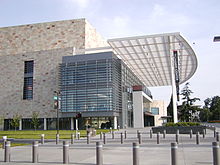
Size and location
Although named after the City of Davis, the campus is technically located adjacent to the City of Davis in an unincorporated part of Yolo and Solano counties. The main campus is located 15 miles (24.1 km) west of Sacramento in the Sacramento Valley, part of California's Central Valley, and is adjacent to Interstate 80.
The city of Davis is a college town, with the ratio of students to long-term residents estimated at 1:4. Also contributing to the college-town environment is the close proximity of downtown Davis to the campus' main quad—a matter of a few blocks, and 5- to 10-minute walk or bike ride. Davis' 15-minute distance from Sacramento provides it with both the isolation critical to fostering a college-town environment while also providing a lively and large metropolitan area nearby. Although the campus itself is vast, the entire community of Davis is relatively small and is easily traversable on bike utilizing Davis' extensive bicycle trails.[46] The campus is the largest Campus in the UC system.
Campus Core/Quad
Towards the northeast end of campus is the Quad, a large rectangular field, which was the historic geographic center of campus. Earlier in the campus' history, the few campus buildings surrounded the four sides of the Quad. Today, though the campus has grown significantly and the geographic center of campus has shifted, the Quad remains the center of campus life, anchored to the north by the Memorial Union (student union), to the south by Shields Library and to the west and southeast by Wellman and Olson halls respectively. The Memorial Union Complex houses Freeborn Hall and the Memorial Union, which houses various establishments such as the UC Davis Bookstore.
The northeast side of campus holds more of the core buildings that were built earlier in UC Davis's history, such as Wellman Hall, Shields Library, Mrak Hall, and Hutchison Hall. Also notable in this northeastern corner is the labyrinthine Social Sciences and Humanities building designed by Antoine Predock, known to students as the "Death Star" for its angular, metallic design.[47]
South Main Campus and South Campus
The majority of Equestrian Center, and Animal Sciences buildings are located near the Arboretum Waterway, away from the core campus; the West Entry Parking Complex, the Silo Union, and the newly constructed Science Lecture Hall and the Science Laboratory Building are located nearer to the Tercero residence halls and the core of campus. The Mondavi Center, home of the University Symphony Orchestra and other cultural events, is also located near the Tercero complex.[46][48]
West Campus
For most of UC Davis' history, West Campus has served primarily as agricultural research land. Recently, portions were developed through a $300 million public-private partnership to form the largest zero net energy community in the United States, known as UC Davis West Village.[49] West Village will provide housing for 3,000 students, faculty and staff and will help the university recruit and retain top faculty. The project will include 662 apartments, 343 single-family homes, 42,500 square feet of commercial space, a recreation center and study facilities. West Village will also host the first community college on a UC campus.
The classes held in this area mainly involve plant sciences, but also include entomology courses as well. Students in the plant sciences maintain gardens as part of the PLS 5 lab while Entomology 156L and 158 students embark on field trips to sample fish for parasites at Putah Creek and conduct projects in forensic entomology at the UC Davis ecosystem, respectively. West Campus is also home to the University Airport, Foundation Plant Services, the California National Primate Research Center, and the Contained Research Facility, a bio-safety level 3 facility.[46]
Arboretum
To the south side of the campus core is the 100-acre UC Davis Arboretum, which includes 3.5 miles of paved paths, 4,000 tree specimens, Putah Creek and Lake Spafford.[50] On March 10, 2017, a multi-year waterway enhancement project began.[51]
Artwork
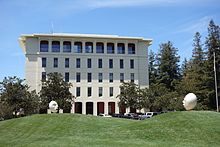
There are seven public art statues found around campus, collectively called The Egghead Series, sculpted by the late Robert Arneson, who also taught at Davis from 1962 to 1991.[52]
Bookhead is located at the Shields Library plaza, Yin & Yang is located at the Fine Arts Complex, See No Evil/Hear No Evil is at the east lawn of King Hall (the main building for UC Davis' School of Law), Eye on Mrak (FatalLaff) is outside Mrak Hall (housing the registrar office and other administrative offices), and Stargazer is located between North Hall and Young Hall. The Yin & Yang egg heads have been recast and duplicated for installation near the Port of San Francisco Ferry Building in San Francisco.[53]
Museums on campus include the C.N. Gorman Museum, specializing in indigenous and Native American art;[54] and the Manetti Shrem Museum of Art, with a focus on local artists from the Bay Area Figurative Movement, Pop art and Funk art movements.
Student housing
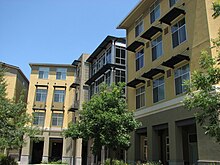
UC Davis Student Housing operates 23 residence halls totaling 29 buildings which are organized into three areas: Segundo, Tercero, and Cuarto.[55] UC Davis Student Housing is large enough to accommodate over 11,000 students. Typically, campus operated housing is reserved exclusively for first-year students, whereby other students are required to seek housing off-campus at apartments or rented homes. The northwest end of campus holds the majority of the Segundo undergraduate housing complex, and various alternative housing sites, such as Orchard Park, Russell Park, The Colleges at LaRue Apartments, and Primero Grove. The Activities and Recreation Center, or the ARC, is also located near the Segundo complex. Adjacent to the northwest corner of campus is the Cuarto undergraduate housing complex, which has one dining commons.
The Tercero undergraduate housing complex is located near the geographic center of the UC Davis campus, to the north of the Arboretum Waterway. This extends longitudinally through almost the entirety of the south end of campus. Solano Park, UC Davis' family housing complex, is located adjacent to the Arboretum Waterway, at the Eastern end of campus. The Davis Arboretum is a public botanic garden with over 4,000 kinds of trees and plants, including many California native plants, which has been developed over 100 acres (40 ha) along The Waterway. The Cuarto undergraduate (freshmen and transfer students) housing complex is located one block off-campus, across Russell Boulevard. Unlike the other undergraduate housing complexes, Cuarto is located within city limits; its residents may vote in city elections.[citation needed]
Organization and administration
The entire University of California system is governed by the regents, a 26-member board, as established under Article IX, Section 9 of the California Constitution.[56] The board appoints the university's principal officers including the system-wide president and UC Davis Chancellor.
The UC Davis Chancellor has overall responsibility for the leadership, management, and administration of the campus and reports to the President of the University of California system, a position currently held by the former president of Ohio State University (and chancellor of UC Irvine), Michael Drake, whose predecessor was former Secretary of Homeland Security and Arizona Governor Janet Napolitano.
The Offices of the Chancellor and Provost is headed by the executive vice-chancellor and provost (EVCP). In their capacity as executive vice-chancellor, the EVCP shares with the chancellor in the overall leadership and management of campus administration and operations, whereas as provost, the EVCP is UC Davis' chief academic officer.
The senior staff provides executive support to the Offices of the Chancellor and Provost. The Council of Deans and Vice-Chancellor consists of the heads of the university's major academic and administrative units.[57]
Students are most likely to interact with or be directly affected by the Office of Student Affairs, which is run by the vice chancellor of student affairs, currently Fred Wood, and by a variety of associate and assistant vice-chancellors. This office oversees many campus units including: Admissions, Athletics, Campus Recreation, Campus Unions, Counseling and Psychological Services, Financial Aid, Student Housing and others.[58]
Student demographics
| Race and ethnicity[59] | Total | ||
|---|---|---|---|
| Asian | 28% | ||
| Hispanic | 24% | ||
| White | 22% | ||
| Foreign national | 16% | ||
| Other[a] | 7% | ||
| Black | 2% | ||
| Economic diversity | |||
| Low-income[b] | 32% | ||
| Affluent[c] | 68% | ||
In 2014, Chancellor Katehi stated that UC Davis aimed to become a Hispanic-Serving Institution by the 2018–2019 school year, with at least 25% of the undergraduate student body consisting of Latinos.[60] Women comprised 60.4% of undergraduates in Fall 2018.[61]
Census data
University of California-Davis | |
|---|---|
| Country | United States |
| State | California |
| County | Yolo |
| Population (2020) | |
| • Total | 8,525 |
| Time zone | UTC-8 (Pacific) |
| • Summer (DST) | UTC-7 (PDT) |
In 2010, the United States Census Bureau made the UC Davis campus its own separate census-designated place for statistical purposes.[62] The campus location is out of the bounds of the Davis city limit. Per the 2020 census, the population was 8,525.[63]
| Census | Pop. | Note | %± |
|---|---|---|---|
| 2010 | 5,786 | — | |
| 2020 | 8,525 | 47.3% | |
| U.S. Decennial Census[64] 2020[65] | |||
2020 census
| Race / Ethnicity | Pop 2010[66] | Pop 2020[65] | % 2010 | % 2020 |
|---|---|---|---|---|
| White alone (NH) | 2,172 | 4,046 | 37.54% | 47.46% |
| Black or African American alone (NH) | 136 | 339 | 2.35% | 3.98% |
| Native American or Alaska Native alone (NH) | 12 | 102 | 0.21% | 1.20% |
| Asian alone (NH) | 2,424 | 2,079 | 41.89% | 24.39% |
| Pacific Islander alone (NH) | 7 | 155 | 0.12% | 1.82% |
| Some Other Race alone (NH) | 17 | 31 | 0.29% | 0.36% |
| Mixed Race/Multi-Racial (NH) | 290 | 364 | 5.01% | 4.27% |
| Hispanic or Latino (any race) | 728 | 1,409 | 12.58% | 16.53% |
| Total | 5,786 | 8,525 | 100.00% | 100.00% |
Note: the US Census treats Hispanic/Latino as an ethnic category. This table excludes Latinos from the racial categories and assigns them to a separate category. Hispanics/Latinos can be of any race.
Academics
The university has 102 undergraduate majors and 101 graduate programs.[67] It has a Department of Viticulture and Enology (concerning the scientific study of grape-growing and winemaking) that has been and continues to be responsible for significant advancements in winemaking utilized by many Californian wineries. The campus claims to be noted for its top-rated Agricultural and Resource Economics programs[68] and the large Department of Animal Science through which students can study at the university's own on-campus dairy, meat-processing plant, equestrian facility, and experimental farm. Students of Environmental Horticulture and other botanical sciences have many acres of campus farmland and the University of California, Davis, Arboretum at their disposal. The Department of Applied Science was founded and formerly chaired by physicist Edward Teller. The arts are also studied extensively on campus with subjects such as studio art, design, music, theater and dance. The Design Department at UC Davis is the only comprehensive academic design unit of the University of California system.[69] There is also the Mondavi Center for the Performing Arts which features artists from all over the globe.
UC Davis undergraduate majors are divided into four colleges:
- UC Davis College of Agricultural and Environmental Sciences
- UC Davis College of Biological Sciences
- UC Davis College of Engineering
- UC Davis College of Letters and Science
Rankings
|
|
|||||||||||||||||||||||||||||||||||||||||||||||||||||||||||||||||||||||||||
